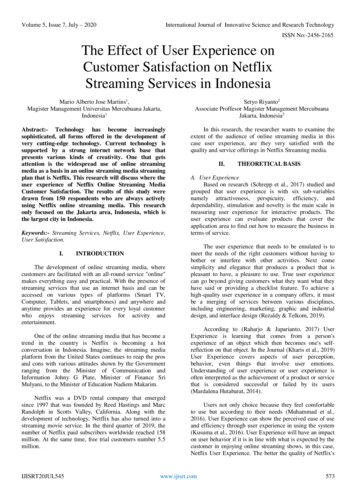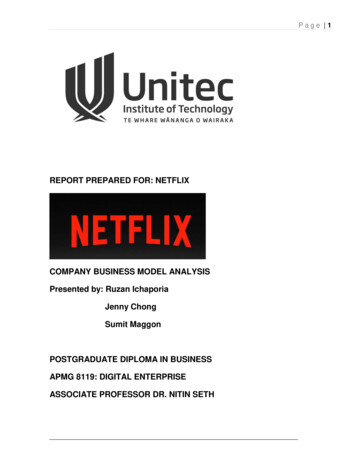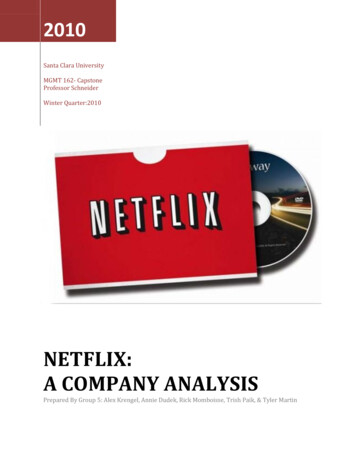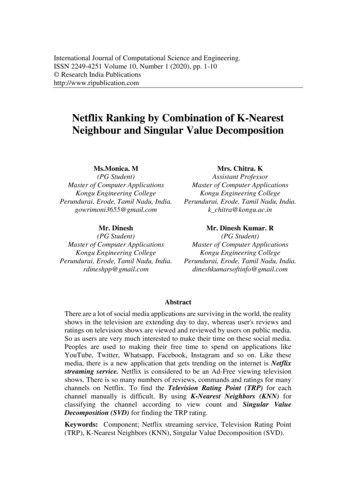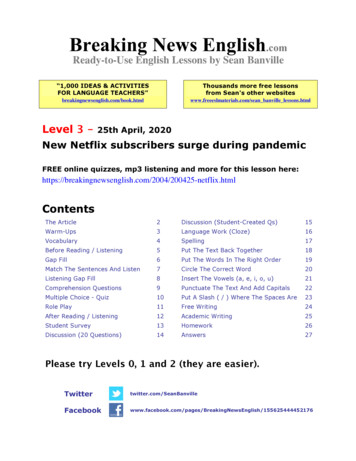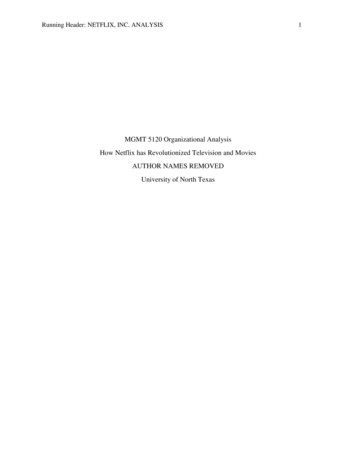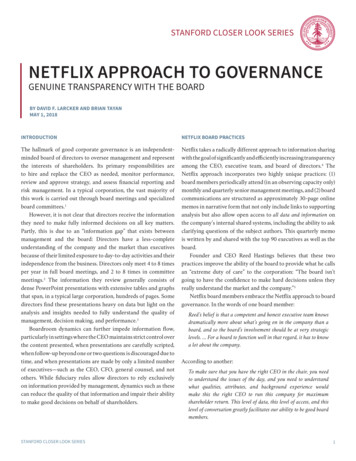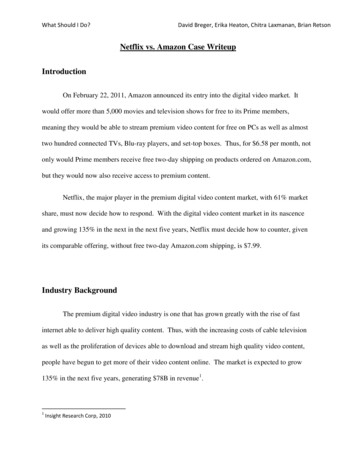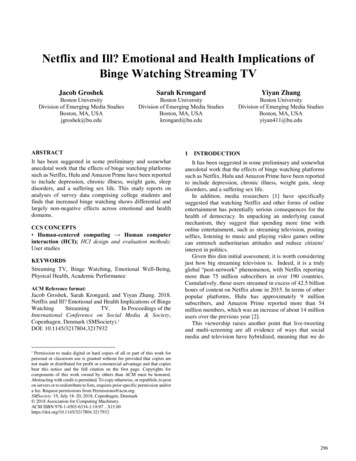
Transcription
Netflix and Ill? Emotional and Health Implications ofBinge Watching Streaming TVJacob GroshekSarah KrongardYiyan ZhangBoston UniversityDivision of Emerging Media StudiesBoston, MA, USAjgroshek@bu.eduBoston UniversityDivision of Emerging Media StudiesBoston, MA, USAkrongard@bu.eduBoston UniversityDivision of Emerging Media StudiesBoston, MA, USAyiyan411@bu.eduABSTRACT1It has been suggested in some preliminary and somewhatanecdotal work that the effects of binge watching platformssuch as Netflix, Hulu and Amazon Prime have been reportedto include depression, chronic illness, weight gain, sleepdisorders, and a suffering sex life. This study reports onanalyses of survey data comprising college students andfinds that increased binge watching shows differential andlargely non-negative effects across emotional and healthdomains.It has been suggested in some preliminary and somewhatanecdotal work that the effects of binge watching platformssuch as Netflix, Hulu and Amazon Prime have been reportedto include depression, chronic illness, weight gain, sleepdisorders, and a suffering sex life.In addition, media researchers [1] have specificallysuggested that watching Netflix and other forms of onlineentertainment has potentially serious consequences for thehealth of democracy. In unpacking an underlying causalmechanism, they suggest that spending more time withonline entertainment, such as streaming television, postingselfies, listening to music and playing video games onlinecan entrench authoritarian attitudes and reduce citizens’interest in politics.Given this dim initial assessment, it is worth consideringjust how big streaming television is. Indeed, it is a trulyglobal “post-network” phenomenon, with Netflix reportingmore than 75 million subscribers in over 190 countries.Cumulatively, those users streamed in excess of 42.5 billionhours of content on Netflix alone in 2015. In terms of otherpopular platforms, Hulu has approximately 9 millionsubscribers, and Amazon Prime reported more than 54million members, which was an increase of about 14 millionusers over the previous year [2].This viewership raises another point that live-tweetingand multi-screening are all evidence of ways that socialmedia and television have hybridized, meaning that we doCCS CONCEPTS Human-centered computing Human computerinteraction (HCI); HCI design and evaluation methods;User studiesKEYWORDSStreaming TV, Binge Watching, Emotional Well-Being,Physical Health, Academic PerformanceACM Reference format:Jacob Groshek, Sarah Krongard, and Yiyan Zhang. 2018.Netflix and Ill? Emotional and Health Implications of BingeWatchingStreamingTV.In Proceedings of theInternational Conference on Social Media & Society,Copenhagen, Denmark (SMSociety).1DOI: 10.1145/3217804.3217932INTRODUCTION1Permission to make digital or hard copies of all or part of this work forpersonal or classroom use is granted without fee provided that copies arenot made or distributed for profit or commercial advantage and that copiesbear this notice and the full citation on the first page. Copyrights forcomponents of this work owned by others than ACM must be honored.Abstracting with credit is permitted. To copy otherwise, or republish, to poston servers or to redistribute to lists, requires prior specific permission and/ora fee. Request permissions from Permissions@acm.org.SMSociety '18, July 18–20, 2018, Copenhagen, Denmark 2018 Association for Computing Machinery.ACM ISBN 978-1-4503-6334-1/18/07 15.00https://doi.org/10.1145/3217804.3217932296
SMSociety, July 2018, Copenhagen, Denmarknot just “watch TV” anymore. As such, it can be argued [2]that online social television is an immersive lean-forwardactivity, not “passive” consumption in the traditional senseof broadcast or cable television.Yet, it is clear that the fields of media research and publicopinion do not theorize or empirically examine streamingTV in a meaningful way. In fact, there is almost no work onthis burgeoning area at all. Debates remain ongoing aboutconventional TV and its role to social capital and civicengagement [3], political knowledge and voting[4], and “themean world” syndrome [5].When, however, considering the social media logic andpersonalization of streaming television [6] as well as how“viewing” is no longer solitary but shared across multiplescreens [7], suggests the need for greater granularity andprecision in understanding a monumental shift in theproduction, distribution, and uses of television as a medium.As of yet, this phenomenon is severely understudied,particularly in emotional and health contexts.The work-in-progress reported here is examines whicheffects can be observed in exploring how streamingtelevision may be situated as an emerging phase in thecontinuum of media personalization. Indeed, this isspecifically because this relatively active and highlyindividualized form of television use might fundamentallyreshape not only the medium, but also the agency ascribedto its users and its uses in a variety of social and culturalarenas.Thus, this project represents one of the first empiricalexaminations of streaming television to date. Specifically,this research looks to examine how the increased use ofinternet-enable television such as Netflix, Hulu, andAmazon Prime relate to a wide range of germane factorsincluding the cultivation of empathy, wellness, andacademic performance.22.1METHODSSampleData for this study as presented here was collected inMarch and April 2016, and comprised 420 respondents froma large private college in the Northeastern region of theUnited States. Given the variety of the respondents, there areobvious limitations in generalizing these results onto thegeneral public. There is limited external validity, and, in thefuture, a wider data pool should be sampled. While there arelimitations to perfect generalization [8], [9], this type ofsampling is regularly reported using inferential statistics,and waves of continued data collection are ongoing,inclusive of quantitative, qualitative, and computationalapproaches.Groshek, Krongard, & Zhang2.2Concepts and Data - EmotionsThis section explores the relationship between streamingtelevision and the social and emotional lives of viewers. Byexamining findings from survey data, we attempt to betterunderstand the contemporary landscape.2.2.1 Empathy and Emotional Well-being. Streamingtelevision falls within the larger cultural conversation abouttechnology and the growing “empathy gap,” in whichindividuals are allowed to feel connected to others while notactually meaningfully engaging with others because they arehiding behind their television, tablets, and phones [10].But what if the empathy gap is actually an empathybridge? What if new technologies could cultivate rather thanimpede upon the development of empathy? Streamingtelevision has popularized the practice of binge-watching,where viewers consume several episodes of one specificprogram in a short period of time. What happens to ourempathy when we spend lengthy amounts of concentratedtime in crafted, imaginary worlds, viewing television in theway the one would read an epic novel? Within this concept,we explore streaming television’s potential to bolsterempathy among viewers.Building upon similar social research in written literature[11], [12], [13] and award-winning dramatic television [14],we aim to understand the relationship between streamingtelevision viewership and empathy.2.2.2 Life Satisfaction and Fear of Missing Out. Fear ofmissing out, colloquially known as FOMO, is particularlyprevalent among millennials. From the collected data, wetease out television’s role as social connector, disconnector,and/or conduit. We discuss the relationship among lifesatisfaction, happiness, and streaming televisionconsumption. Does streaming television consumptionalleviate this fear, or do those who consume more streamingtelevision experience greater FOMO? Ultimately, how doesstreaming television fit into a larger context of socialpriorities?2.2.3 Cultivation and Trust in Others. Since the earlydays of television, researchers have asserted that those whospend more time “living” in the world of television begin tosee social reality through a TV lens [5]. This theory,commonly known as “mean world syndrome” or cultivation,has remained the dominant theory in understanding howtelevision affects us socially, even though television haschanged from a talking home appliance to an interactive,personalized viewing platform.Yet, one key aspect of the analyses applied here is toexamine the extent to which cultivation theory still appliesin an era of algorithmically determined hyper-personalizedcontent.2.3Concepts and Data - HealthFor years, researchers have been pronouncing the postmortem on allegedly unhealthy television-viewing habits. It297
Netflix and Ill?has been reported that too much TV means increased risk ofheart disease, “lower cognitive function,” increased aging,and even increased risk of death—regardless of how muchwe exercise, how old we are, who our parents are, or howmuch we sleep [15]. Now, with the emergence of streamingtelevision, researchers are also issuing preliminary warningsthat binge-watching (or even the intent to do so) makes uslonelier while making us want to belong even more. It’s adark cycle. TV kills us, kills us faster, makes us dumber, andmakes our shortened lives that much more miserable. Thecurrent study will crucially examine if this is really the fullstory in specific areas of inquiry.2.3.1 Academic Performance. Watching televisionmakes us stupider, right? Wrong – maybe. Even one of thefirst researchers in this area, W.J. Clark, found that televisionviewing did not affect academic performance among 1,0006th and 7th graders in 1951 [16]. Television programs canserve as social surrogates in providing a sense of belonging.Meanwhile, watching or sharing programs with otherpeople, or co-viewing, can contribute to wanting to watchmore.Some research indicates that binge watching is not allbad. For instance, Willens [17] noted the social aspect ofbinge watching, mentioning her “binge-bonding” sessionswith peers, and even suggesting that it has become the new“date night.” She also mentions the competitive aspect ofbinge watching television – that feeling of inferiority whenyou are “behind” everyone in a popular program, or thatsatisfying feeling of behind caught up or ahead of her peersin episodes.2.3.2 Eating Habits, Diet, and Attitudes. A number ofpeople writing in this area consider binge-watching habits anaddiction. One stated that he would stay up into the latehours of the evening, choosing “‘just one more’ hit” overgetting enough sleep. Another likened binge viewing to aneating disorder, lying about her whereabouts and alwayswanting more—even wishing her husband would go on abusiness trip so she could shamelessly binge on her favoriteprograms [18]. Other sources mention not only the negativeconsequences related to the physical inactivity associatedwith binge watching television, but also its possible effectson mood, including feelings of depression and emptiness,feelings of “withdrawal” at the close of a season or program,and emotional exhaustion after all of the highs and lows ofeach episode [19].2.3.3 BMI and Obesity. The most widespread leisurelyactivity, which involves little metabolic activity [20], inadults is watching television [18]. High percentages of adultsin the United Kingdom, 33% of men and 45% of women, failto achieve recommended physical activity levels [21]. Thefourth leading mortality risk factor is a lack of physicalactivity [22] and so it is important to identify what factorsare potentially preventing people from achieving healthylevels of physical activity. Behavior that is sedentary isSMSociety, July 2018, Copenhagen, Denmarkknown to be linked with problematic health outcomesindependent of physical activity [23]. Time spent watchingtelevision has also been correlated reduced sleep time andobesity [24].Lifestyle behaviors adults pick up early in their livescould risk cognitive impairment in midlife and couldreinforce potential roles for both physical and sedentaryactivities as modifiable risk factors for prevention [25]. Wetherefore incorporate this important effects dimension ofincreased use of streaming television.33.1RESULTS AND DISCUSSIONOverall Use of Streaming TVWith YouTubeTV, Chromecast, Roku, AppleTV,SmartTVs and many more applications and interfaces tostream television, it is worth considering if users may bestreaming too much TV and what those effects are.In the sample of college students that we surveyed, it wasshown that on average, college students spent 3.36 hours onTV (through online streaming), 3.02 hours via smartphone,2.88 hours on laptop, 2.80 hours on TV (through cable,broadcast or dish), 1.71 hours on desktop computer, and 1.59hours on tablet. Altogether, these students collectivelyaveraged 15.36 hours of streaming video per day, onaverage, across screens. Specifically, this included 3.36hours on TV (through online streaming), 3.02 hours ofstreaming on smartphones, 2.88 hours on laptop, 2.80 hourson TV (through cable, broadcast or dish), 1.71 hours ondesktop computer, and 1.59 hours of streaming per day viatablets. 36.19% binge-watched more than 3 TV series in thelast month. On average, students binge watched 2.59 seriesper month.While data analyses are ongoing, preliminary resultssuggest there are some statistically significant differences incertain areas of student emotion and health outcomes. Forexample, main effects are reported in Fig. 1, where it is clearthat risk perceptions increase for both males and females athigher levels of streaming television (p .05 in FactorialAnalysis of Variances (ANOVAs).298
SMSociety, July 2018, Copenhagen, DenmarkGroshek, Krongard, & ZhangFinally, at least among the initial analyses reported here,it can again be observed that there are interactions withstreaming TV frequency, gender, and health attitudes. Asshown in Fig. 3, heavy streaming males had the highestlevels (p .05 in Factorial ANOVAs) of self-reported healthperceptions and other analyses of BMI and stress were nonsignificant.Figure 1: Relationships between Perceptions of Risk, Gender,and Frequency of Streaming Television.In terms of academic performance, one of our initialanalyses indicates that the heavy frequency of streamingtelevision (those in the upper third percentile) actuallyreported higher GPAs than those with a moderate level ofstreaming activity. These results are summarized in Fig. 2,which again indicated a statistically significant main effect,but also an interaction effect among males at the heaviestlevel of streaming television (p .05 in Factorial ANOVAs).Figure 3: Relationships between Health Perception, Gender,and Frequency of Streaming Television.4CONCLUSIONSThese findings suggest that engaging with streamingplatforms, which use algorithms to personalize contentoptions to users, is a substantively different activity fromsimply seeing “what’s on” broadcast or cable. Rather thanmerely watching in the more passive model of traditional TVconsumption, streaming viewers are using a system that letsthem watch whatever they want, whenever and whereverthey choose. Users more actively choose what they watchwith more control and engagement with their options andothers.Evidence presented here suggests that streamingtelevision can translate into increased agency with oftenpositive (or at least non-negative) effects. This shift, alongwith the ongoing transition to subscription-baseddistribution modes, has the potential vastly reshape the fieldof media effects research but remains relatively unexplored.Figure 2: Relationships between Academic Performance,Gender, and Frequency of Streaming Television.ACKNOWLEDGMENTSThe authors thank GPA Editing for their careful assistance.299
Netflix and Ill?SMSociety, July 2018, Copenhagen, ][11][12][13][14]Elizabeth Stoycheff and Erik Nisbet. 2016. Is internetfreedom a tool for democracy or authoritarianism? TheConversation. (July 2016). Retrieved May 30, 2018from ool-for-democracy-or-authoritarianism-61956Jacob Groshek and Sarah Krongard. 2016. Netflix andengage? Implications for streaming television onpolitical participation during the 2016 US presidentialcampaign. Social Sciences 5, 4 (Oct. 2016), 65-74. DOI:https://doi.org/10.3390/socsci5040065Robert D. Putnam. 2000. Bowling alone: The collapseand revival of American community. Simon andSchuster: New York, NY.Matthew Gentzko. 2006. Television and voter turnout.The Quarterly Journal of Economics 121, 3 c.121.3.931Goerge Gerbner and Larry Gross. 1976. Living withtelevision: The violence profile. Journal ofCommunication 26, 2 (June 1976), 172-194. 97Jose van Dijck and Thomas Poell. 2013. Understandingsocial media logic. Media and Communication 1, 1(Aug. 2013), 2-14. Retrieved May 30, 2018 fromhttps://ssrn.com/abstract 2309065Homero Gil de Zúñiga, Victor Garcia-Perdomo, andShannon C. McGregor. 2015. What is second screening?Exploring motivations of second screen use and itseffect on online political participation. Journal ofCommunication 65, 5 (July 2015), 793-815. DOI:https://doi.org/10.1111/jcom.12174Reg Baker, Stephen Blumberg, J. Michael Brick et al.2010. AAPOR Report on Online Panels. (June sJason Peifer and Kelly Garrett. 2014. Best practices forworking with opt-in online panels. (April sites/comm.osu.edu/files/Optin panel best practices.pdfSherry Turkle. 2015. Reclaiming Conversation: ThePower of Talk in a Digital Age. Penguin Press, NewYork, NY.Raymond A. Mar, Keith Oatley, Jacob Hirsh, Jenniferdela Paz, and Jordan B. Peterson. 2006. Bookwormsversus nerds: Exposure to fiction versus non-fiction,divergent associations with social ability, and thesimulation of fictional social worlds. Journal ofResearch in Personality 40, 5 (Oct. 2006), 694-712.DOI: https://doi.org/10.1016/j.jrp.2005.08.002Raymond A. Mar and Keith Oatley. 2008. The functionof fiction is the abstraction and simulation of socialexperience. Perspectives on Psychological Science 3, 745-6924.2008.00073.xDavid Comer Kidd and Emanuele Castano. 2013.Reading literary fiction improves theory ofmind. Science 342, 6156 (Oct. 2013), 377-380. DOI:https://doi.org/10.1126/science.1239918Lindsey I. Black, Tainya C. Clarke, Patricia M. Barnes,Barbara J. Stussman, and Richard L. Nahin. 2015. Useof complementary health approaches among childrenaged 4–17 years in the United States: National HealthInterview Survey, 2007–2012. National HealthStatistics Reports 78, 1 (Feb. 2015), 1–19. ed/25671583William W. Gaver. 1991. Technology affordances. InProceedings of the SIGCHI Conference on HumanFactors in Computing Systems (CHI ’91). ACM Press,New Orleans, LA, 79-84. DOI: https://doi.org/10.1145/108844.108856William J. Clark. 1951. Of Children and Television.Cincinnati, Ohio: Xavier University.Michele Willens. 2013. Face it: Binge-viewing is thenew date night. The Huffington Post. (March y-breaking-bad-houseofcards b 2764830.htmlKatrien Wijndaele, Soren Brage, Herve Besson et al.2010. Television viewing time independently predictsall-cause and cardiovascular mortality: the EPICNorfolkstudy. InternationalJournalofEpidemiology 40, 1 (Feb. 2011), 150-159. DOI:https://doi.org/ 10.1093/ije/dyq105Chris Smith. 2014. The Netflix effect: How bingewatching is changing television. TechRadar. e-watching-is-changing-television1215808Frank B. Hu, Tricia Y. Li, Graham A. Colditz et al.2003. Television watching and other sedentarybehaviors in relation to risk of obesity and type 2diabetes mellitus in women. JAMA 289, 14 (April 89.14.1785National Health Service. 2015. Health Survey forEngland 2014. NHS, The Health and Social CareInformation Centre,London, England. Retrieved May 30, 2018 lth-survey-for-england-2014World Health Organization. 2010. World ho.int/whosis/whostat/2010/en/J. Lennert Veerman, Genevieve N. Healy, Linda J.Cobiac et al. 2011. Television viewing time and reducedlife expectancy: a life table analysis. British Journal ofSports Medicine 46, 13 (Oct. 2012), 927-930. DOI:https://doi.org/10.1136/bjsm.2011.085662Jesus Vioque, Alberto Torres, and Joan Quiles. 2000.Time spent watching television, sleep duration andobesity in adults living in Valencia, Spain. InternationalJournal of Obesity 24, 12 (Dec. 2000), 1683-1688.DOI: https://doi.org/ 10.1038/sj.ijo.0801434Tina D. Hoang, Jared Reis, Na Zhu et al. 2016. Effectof early adult patterns of physical activity and televisionviewing on midlife cognitive function. JAMAPsychiatry 73, 1 (Jan. 2016), 73-79. DOI:https://doi.org/ 0][31][32]300
such as Netflix, Hulu and Amazon Prime have been reported to include depression, chronic illness, weight gain, sleep disorders, and a suffering sex life. This study reports on analyses of survey data comprising college students and finds that increased binge watching shows differential and largely non-negative effects across emotional and .
